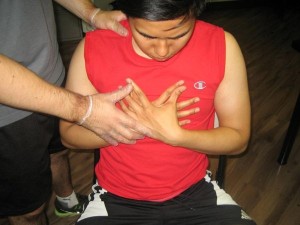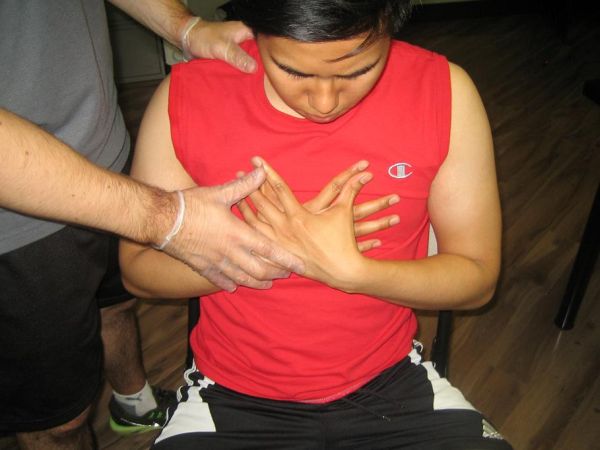
When providing first aid for injuries involving the chest, always keep in mind that major body organs and structures, such as the heart, lungs, great blood vessels, liver, trachea, spleen, stomach, and gallbladder, may have been affected and first aid training helps save lives of many people. Also remember that injuries to the back can also affect the structures of the chest cavity. Many of the organs in the chest cavity are closely attached to the back muscles. Any forceful impact to the back can cause problems.
Injuries to the chest can occur in a number of ways that include:
- Blunt trauma – Impact to the chest can fracture the breastbone (sternum), rubs, and its supporting structures. In some cases, the parts or the whole sections of the chest may collapse. In severe blunt trauma, the airway and lungs can be damaged, with the heart seriously injured. This emergency situation is more commonly seen in motor accidents, sports accidents and occupation-related accidents.
- Compression – This is a more severe form of blunt trauma to the chest. In this situation, the chest is compressed into a fixed surface by a forceful impact. This is most commonly seen in motor vehicle accidents wherein the driver pitches forward after a head-on collision and buries his chest into the steering wheel. In this emergency, the lungs can be ruptured, the heart severely squeezed, and the sternum completely or partially fractured.
- Penetrating objects – Knives, bullets, steel rods, pieces of glass or metals, and various other sharp items can penetrate the chest wall, causing damage to the internal organs and resulting in complete impairment of respiration.
Learn the difference between standard first aid and emergency first aid training for you to be able to handle situations like this.
The lungs, heart and great blood vessels may be injured as a result of injuries to the chest. Knowledge of basic cardiac life support is critical in the emergency care of individuals who sustained chest injuries. The first aider should also be alert for possible signs of shock.
Chest injuries may be broadly classified as open or closed:
- Open – Open chest injuries refer to injuries where the patient has open wounds and that the chest cavity has been penetrated. In open chest wounds, an object can pass through the chest wall from the outside, or a broken bone can penetrate the chest wall internally. The lungs and heart may also be injured. Usually, it is difficult to tell whether the chest wall has been penetrated by just looking at the wound. DO NOT attempt to open up the wound to measure its depth.
Closed – As the name suggests, the skin remains intact. Although closed chest wounds do not appear serious, they must be given careful medical attention. Injuries resulting from blunt trauma or compression can cause lacerations and contusions of the lungs, heart and great vessels.

